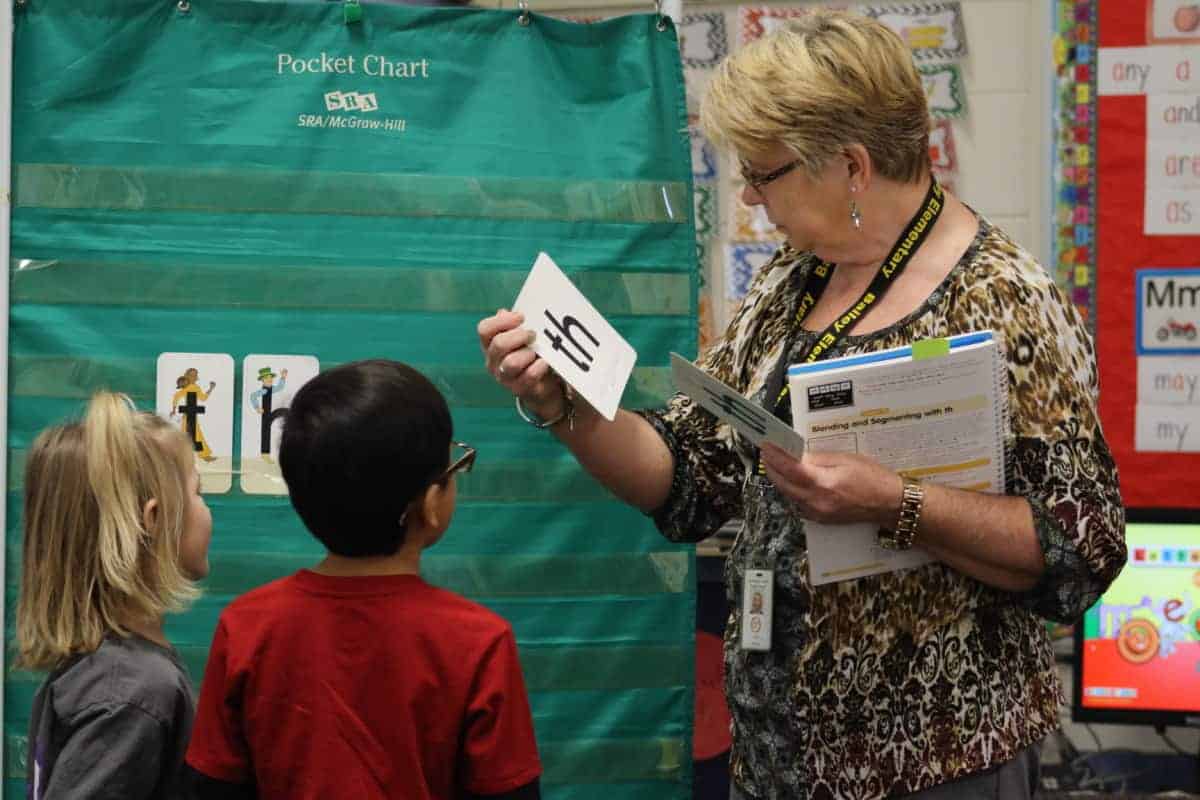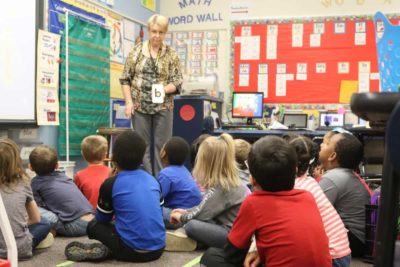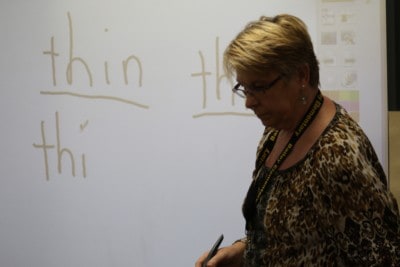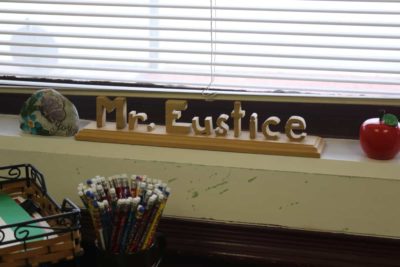Children in Dale Murray’s kindergarten class at Bailey Elementary in Nash County held their thumbs in front of their mouths as they practiced the way their tongues touch their front teeth to make the soft “th” sound. Murray then told a story about Talking Tess and Harry the Hat Man, the characters for “t” and “h” in Letterland, a literacy program Murray and her fellow kindergarten teachers are using for the first time this year.
Murray went on to explain that when there’s a thunderstorm, Harry the Hat Man, who is notoriously silent, hates the noise. So Talking Tess comfortingly says to Harry, “There, there, it’s only thunder!” She asked the students to repeat: “There, there, it’s only thunder!” and picks out the soft and hard “th” sounds in the phrase. These details, Murray said, are helping students learn to blend sounds more quickly than in past years, which is a crucial step in learning to read.
“Right now we’re into the blends and the digraphs,” she said, “and if they know those blends, like c-h, when they get to the word, they won’t say ‘k, h,’ they’ll know, ‘ch.'”
These are the day-to-day intricacies of teaching children to read. At Bailey Elementary, which serves about 600 students in rural Nash County, literacy in the early grades is taken very seriously. Principal Mary Jones, who has taken part in the N.C. Pathways to Grade-Level Reading Initiative, knows the work of getting children where they need to be by third grade, an indicator for success later in school and life. The path to third-grade proficiency starts before elementary school and is impacted by an entire community.
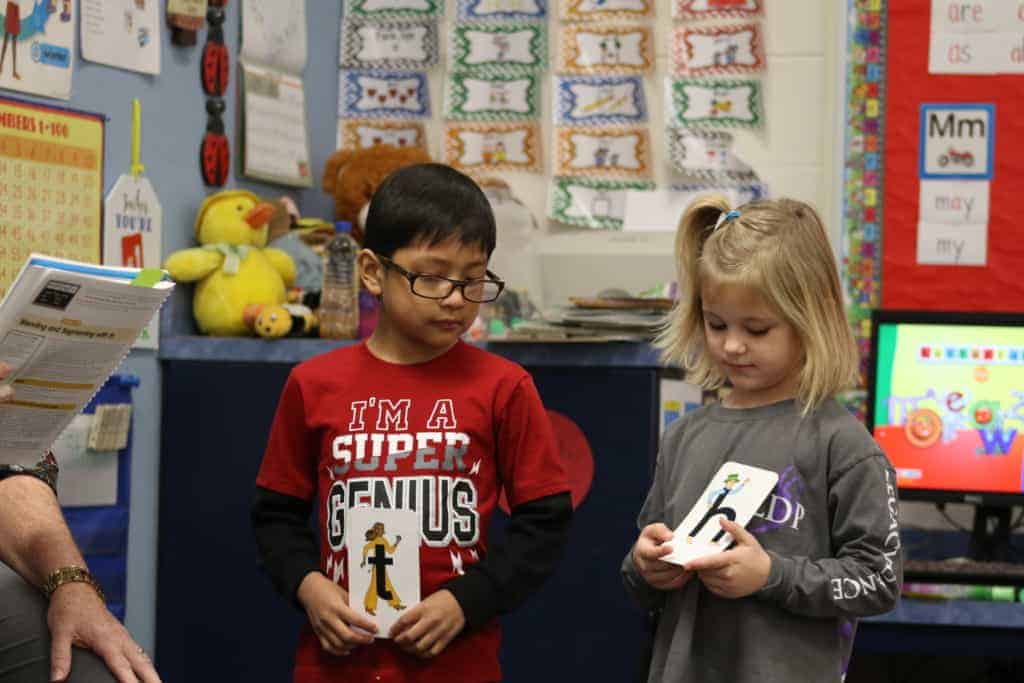

Jones estimated about a third of 100 kindergartners at Bailey this year went to preschool. There are two NC Pre-K classes housed within her school, but no high-quality daycare in the area, she said. She is concerned about a lack of access to high-quality educational settings before kindergarten in a region struggling with poverty and health.
Nash County had a median income from 2012 to 2016 of $43,804 compared to North Carolina’s $48,256. In October 2018, the county’s unemployment rate without seasonal adjustment was 4.4 percent compared to the statewide 3.4 percent. In the area that Bailey serves, many families are English-language learners and work agricultural jobs. In 2016-17, 79 percent of Bailey students were economically disadvantaged. In the 2017-18 grading system, Bailey received a C letter grade, which is based on test scores and year-to-year growth.
“I think we recognize the issues, it’s just how do you resolve this in a rural setting like Bailey?” Jones said. “How do you meet the needs of this community? Obviously there’s 100 kids there. If a third are ready, then you’ve got 70 who needed something that this community couldn’t provide. I mean that’s the math.”
Jones said parental education on the importance of exposure to text and vocabulary early on is needed to help children who are not in formal settings before school.
“From birth to a year old is a time that you need to have conversations with those babies so that they have an understanding of vocabulary,” she said. “They may not be able to mimic or say it back to you, but you don’t want to limit that because they are learning even though they can’t communicate at that level with you.”
This year, Jones is digging into data and finding that kindergartners’ reading proficiency is lagging, partly because of slight changes in state-mandated literacy assessments.


mClass: Reading 3D is used in schools across the state in early grades to monitor students’ reading proficiency as part of the state’s Read to Achieve initiative. Reports from the Friday Institute for Educational Innovation in October and November found the initiative was not making statewide progress in improving early literacy. Read more here on the State Board meeting in January where the reports’ findings were presented.
In mCLASS, students advance from level to level, measured by letters of the alphabet with books for each level. Three assessments are taken throughout the year to give teachers data on where each student needs more help. Jones said kindergartners are struggling in one of the main aspects of reading: comprehension. When it comes to phonics, or sounding out words and being able to read them, most students are on-grade level.
“But the reading foundation is more of the ‘I can say the words;’ the comprehension is more ‘I understand what the words mean.’ So we’re seeing the increase and the celebrations in the foundations aspect, which is the phonics side of it, whereas the comprehension is more challenging because of the level or intensity of the questions.”
Murray said both the provided text and the assessments are harder this year. In the past, when students were asked to read a book during the assessment, the teacher guided the student to tell them to look at the pictures in the book, or take a “picture walk,” and read it twice. That prompting was removed from the assessment language this year.
“It doesn’t sound like a lot, but those little things like that, reading the book two times, looking at the pictures, that’ll help them answer their questions,” Murray said. “If they only take the book and just do the first read, these little kids, their main focus is sounding out the words and trying to get the words right, they’re not paying any attention to the comprehension piece of it.”
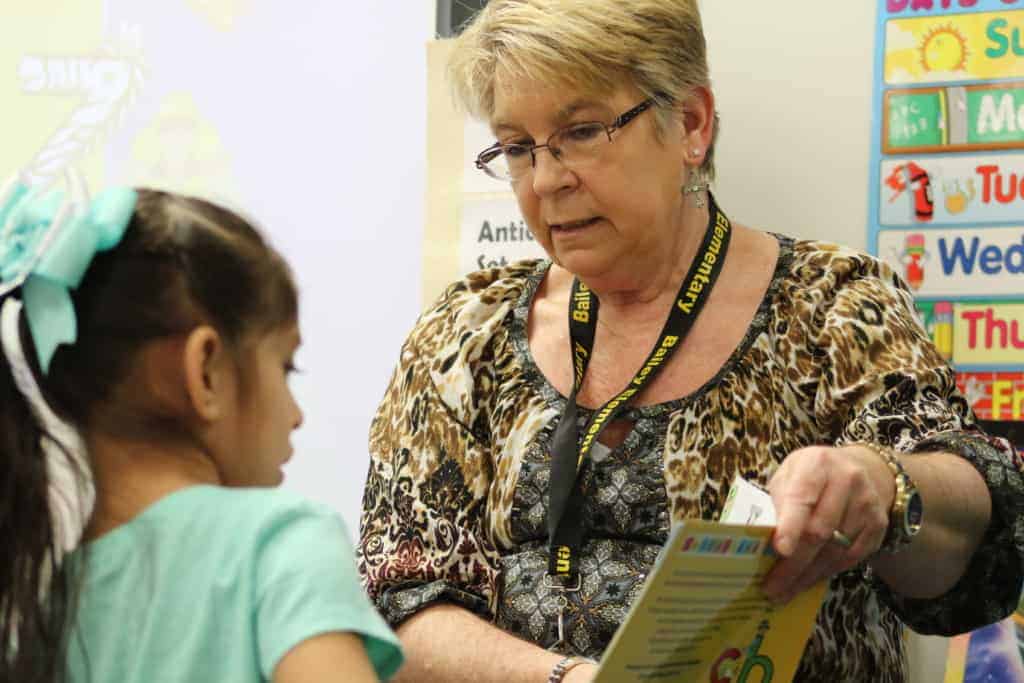

Without the prompting, Murray said students, especially at the beginning of the year, do not know those first steps.
“A lot of the kids, especially to begin with, some of them have never even seen a book, much less [know] what to do with it, and so they’re not naturally going to do the picture walk,” she said. “They’re not going to read it two times. So that’s kind of what we’re falling into this year. Even myself, if I read text one time, I probably couldn’t answer the questions.”
Murray said other small details are new, like requiring a child to identify a question mark instead of just a period and asking what sounds are at the beginning and end of words. Murray said all but three of her students are where they should be in phonics, but that most students are struggling with the comprehension side.
To address this issue, all of Bailey’s kindergarten teachers (besides one dual-language class) have met and are making sure to teach children the strategies — looking at the pictures and reading the book twice — before the assessment and spending extra time on comprehension the rest of the year. “That’s our focus from now to the end,” Murray said. “Reading, reading, site words, comprehension.”
Jones said she believes changes to make assessments more rigorous are intended to help students meet the appropriate standards in third grade. However, there is always a balance of pushing too hard, she said.
“At the end of the day, it’s a fine balance not to push too much on that developmental student. Because what you’re wanting to do is develop a love for reading rather than, ‘Oh my goodness, we have to do this again.’ It’s a balance that you’re trying to strike and keep the kids positive and wanting to read.”
One piece of developing that love for reading, Murray said, has been the role of Letterland. She said one of her students came to kindergarten late this year, around October, without prior educational experience. The student is still behind, she said.
“He knew absolutely nothing,” she said. “He’s still struggling writing his numbers and letters. He’s learned his numbers to 10, still having trouble identifying letters, but I think he’s told me almost every one of his sounds just by that little bit of time he’s been here and been with the other kids with Letterland.”
The program comes with characters for each letter and stories as to why letters and combinations of letters make certain sounds. There are also physical motions, videos, and songs for each lesson to appeal to different types of learners, which Murray says “helps it stick.”
“Before we taught it, we manipulated it, but we didn’t have the stories and the pictures and the songs to really give them that concrete foundation,” she said. “I think it’s going to help.”
